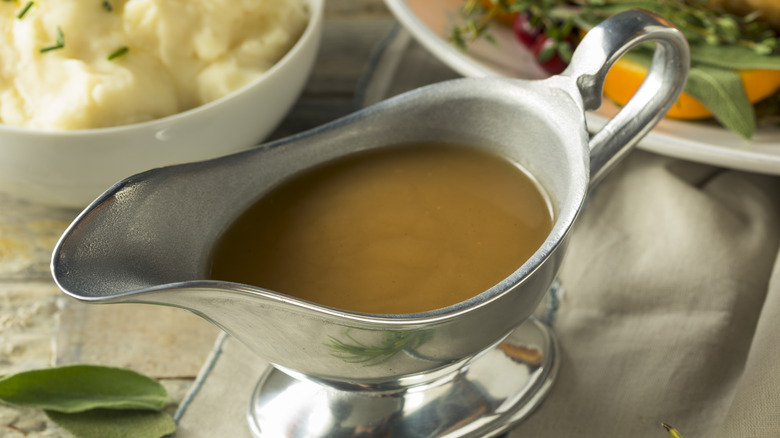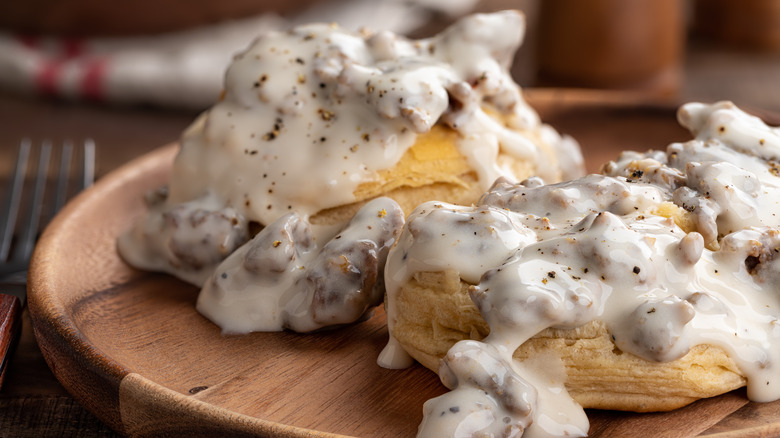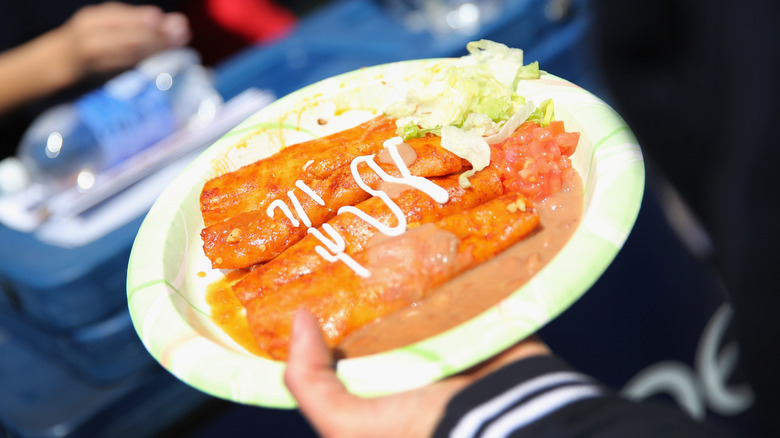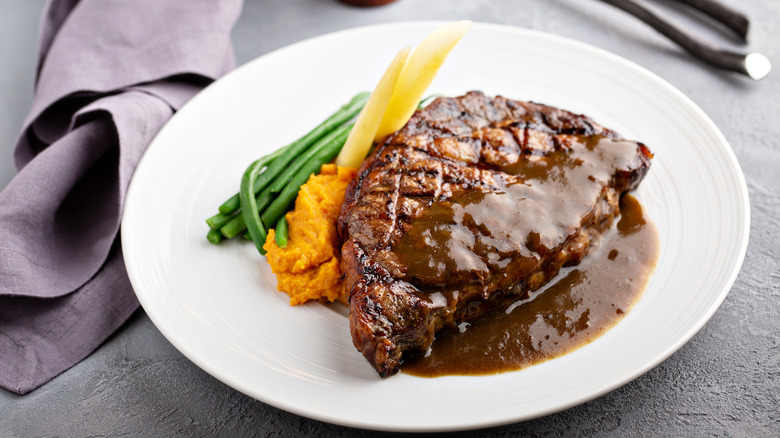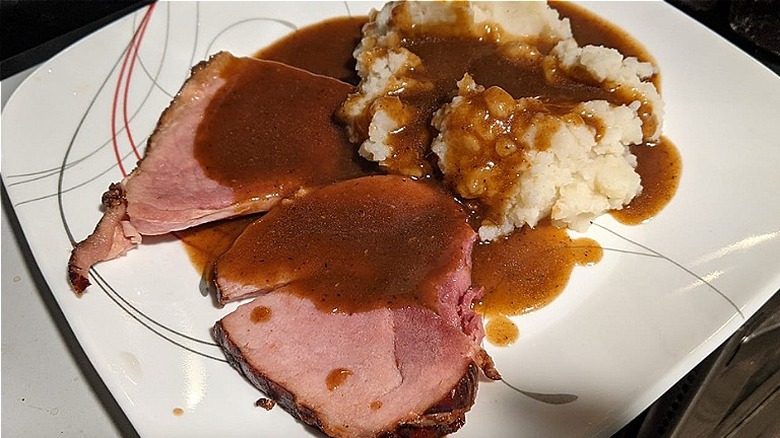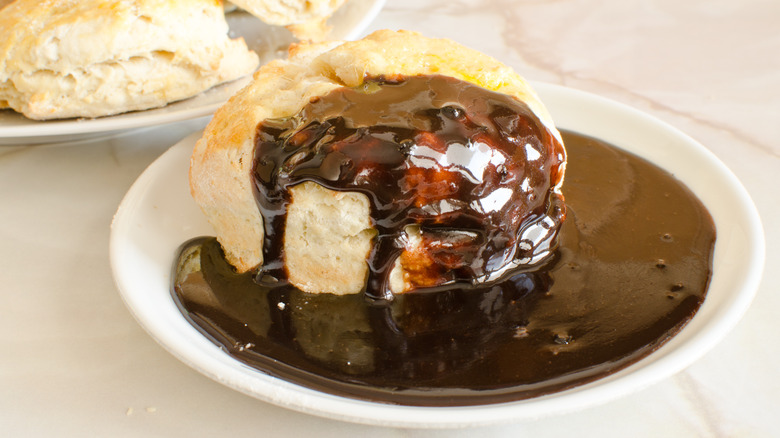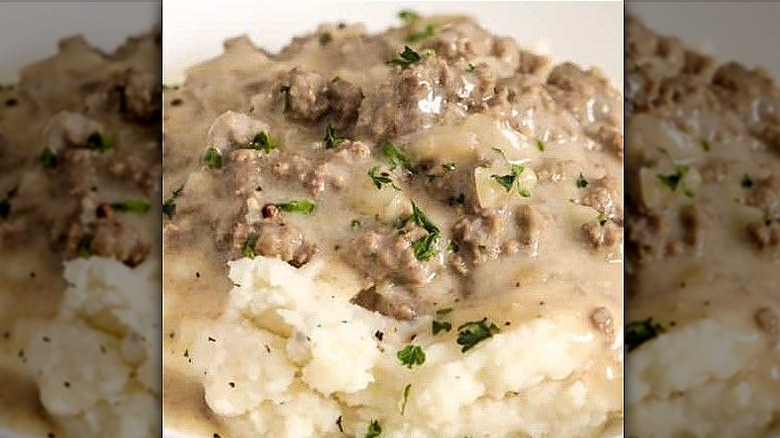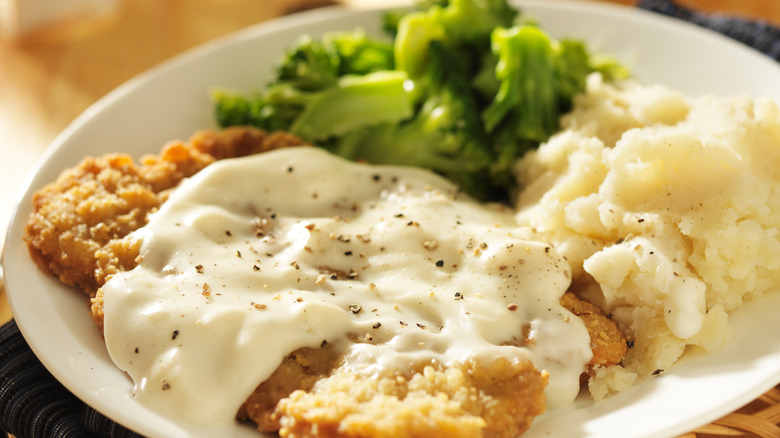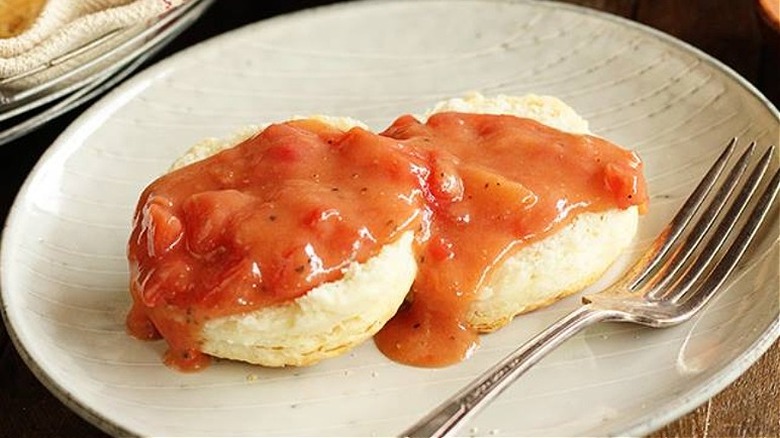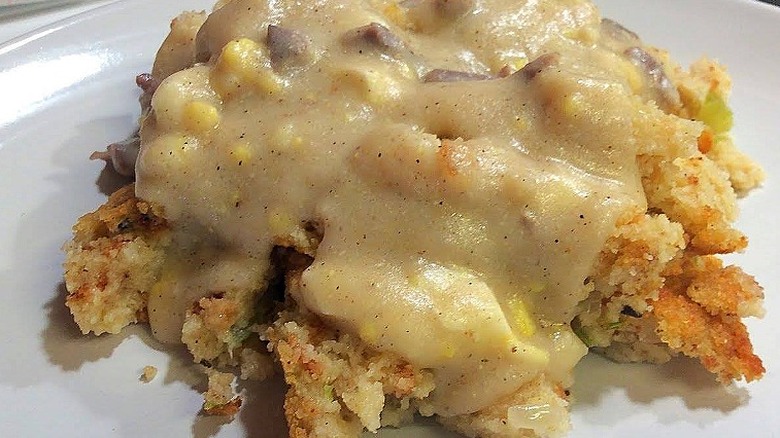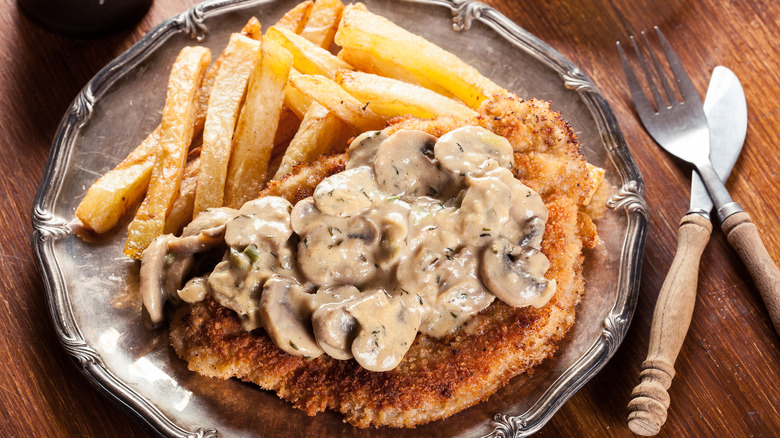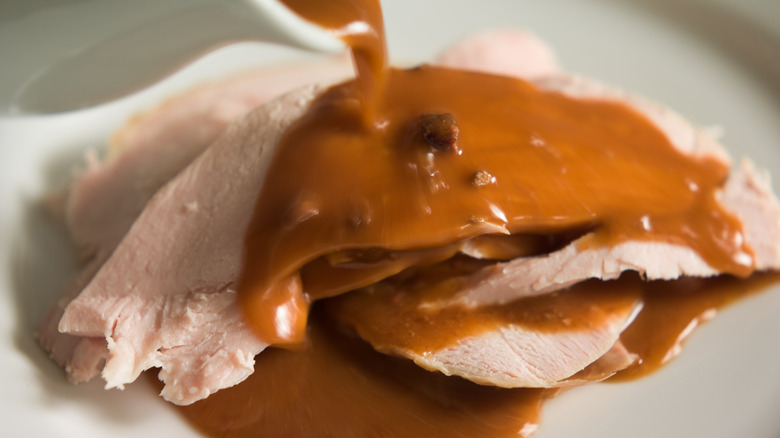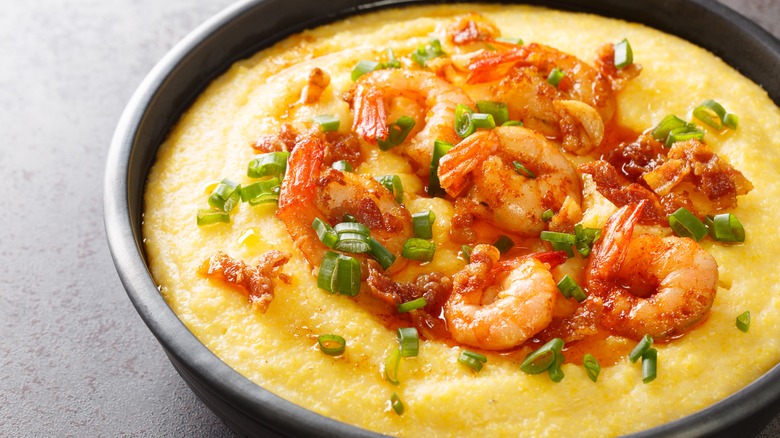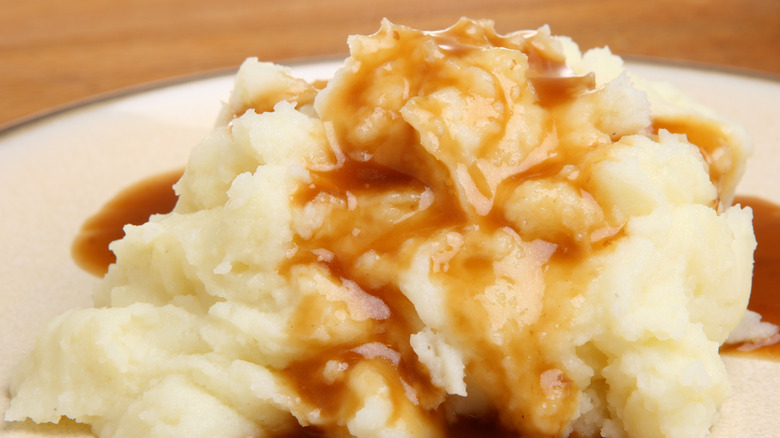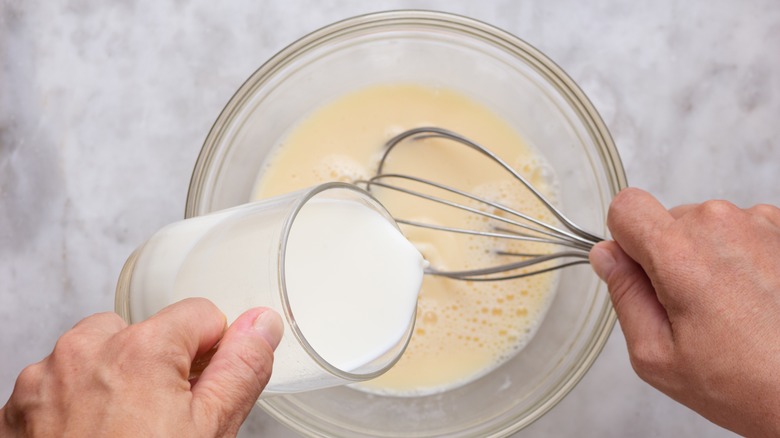14 Regional Gravy Styles You'll Find Across The U.S.
Every Thanksgiving, our turkey and mashed potatoes get slathered with an unctuous heap of steaming brown gravy. Its umami-rich flavor and velvety texture help to moisten a turkey and tie the entire meal together, uniting the ingredients while establishing a sense of time and place. It is a practical and versatile food that has evolved to accommodate locally available resources and to highlight ethnic and cultural differences.
Gravy refers to any sauce created by utilizing the liquid left over from cooking meat, combining it with a thickener, like flour or cornstarch, and dissolving this mixture with a liquid, like broth or milk. The history of using a flavorful sauce with food may date back to the early Roman Empire, when sauces made with a dozen or more ingredients would get poured liberally over foods with dubious origins or freshness. As gravy made its way to America with the early colonists, it became a means of stretching out a meal, a solution to scarcity, enabling people to feed hungry mouths while providing adequate calories and flavor.
Modern-day gravy recipes are as diverse as the United States of America. There are dish, or natural, gravies, pan gravies, and kettle gravies. Each of these gravies requires finesse to achieve the perfect balance of fat to thickener to liquid to create a creamy delight. Let's look at some quintessentially American gravy recipes from across the U.S.
1. Sawmill gravy
When Southerners think of the term "biscuits and gravy," this type of gravy comes to mind. Historically, sawmill gravy evolved during the 1800s, when resourceful Appalachian loggers would hop from one off-the-beaten-path site to another, establishing logging camps. These hard-working loggers needed hearty food to help fuel them through harsh weather and long, arduous workdays. Dense biscuits, which, back then, were nothing like the fluffy ones we now make using leaveners and commercially produced flour, would get covered with a rich gravy made from rendered bacon fat, cornmeal, and milk. Because of the gritty texture the cornmeal gave this gravy, loggers often accused the chefs of making it with sawdust, hence its moniker.
Today, sawmill gravy typically gets made with flour instead of cornmeal, sausage often replacing the bacon drippings, and herbs and spices to jazz up the recipe. However, the legacy of biscuits with gravy is no less integral to Southern culture.
2. Chili gravy
If you have ever eaten a plate of piping hot enchiladas in a Mexican restaurant in the U.S., you've likely had chili gravy. Chili gravy is a classic Tex-Mex invention, the perfect example of two cultures merging their culinary histories. The earliest mention of this type of sauce dates back to the 1890s, and canned versions could be found by the early 1900s.
The sauce begins with lard or oil, which gets thickened with either flour or masa to create a roux. The key to chili gravy lies in the spices used, primarily chili powder, cumin, garlic, smoked paprika, and oregano. Once these spices have toasted, the sauce gets finished with chicken or beef broth. The result is something of a cross between a classic Mexican red enchilada sauce, which gets made with tomatoes, and a brown gravy. This sauce is also commonly used to garnish burritos, rice, and beans. It is also a good base for a classic chili con carne recipe.
3. Brown gravy
Brown or pan gravy is most quintessentially recognized as gravy in Britain. This gravy takes advantage of meat pan drippings whisked together with flour into a dark roux and thinned with beef stock. Its origins likely date back to the Middle English period, which spanned between roughly 1150 and 1450 in Britain, during which the term "gravé" emerged. This term presumably came from the French, as similar recipes were commonplace in that country during medieval times.
While this variation of brown gravy very likely made its way from Britain to America aboard the Mayflower, it became a staple in the post-Civil War U.S. Today, mass-produced variations of brown gravy are available in dried packets, cans, and jars labeled "Brown Gravy." It most often gets served with roast beef and mashed potatoes. For a more sophisticated iteration of a brown sauce, consider making a classic sauce espagnole, which has the added richness of tomato paste with caramelized carrots, celery, and onions.
4. Red-eye gravy
Perhaps no gravy is as quintessentially Southern as red-eye gravy, also known as poor man's gravy, bird-eye gravy, bottom sop, muddy gravy, cedar gravy, and red ham gravy. It's a key component of what is known as a "meat 'n' three" dinner, which includes a choice of meat (often country-fried steak, ham, or pot roast) served with a choice of three side dishes, including potatoes, corn, lima beans, macaroni, cornbread, and biscuits. This feast gets topped off with this delectable gravy made simply from the drippings of a pan-seared, salt-cured, hardwood-smoked country ham and mixed with leftover black coffee. That's it. No flour, no other liquid.
It is exceedingly simplistic, yet its origins are steeped in legend. While some believe red-eye gravy gets its name from how the ham on a plate coated in this sauce looks like a red eye, others insist it is because after you eat this gravy, the caffeine will give you bloodshot eyes. The most popular theory, however, stems from a story about President Andrew Jackson, who purportedly asked the chef of his encampment to make him a gravy that was as red as his eyes were after a night of binge drinking. Whichever story is true, when in the South, do not skip the opportunity to experience this distinctive gravy.
5. Chocolate gravy
The pride of those from Appalachia and the Deep South, chocolate gravy is a dish that evokes nostalgia. It is a simple recipe often made by combining bacon drippings or butter with sugar, flour, cocoa, and milk, creating a sweet treat that can get served over sweet or savory dishes. Chocolate gravy is especially popular with breakfast biscuits, and it is an unspoken rule to crumble your biscuit rather than slice it in half to maximize the quantity of gravy that gets soaked up.
The origins of this gravy are very ambiguous. One theory is that it evolved from the trading network between Spanish Louisiana and the Tennessee Valley, introducing Mexican-style breakfast chocolate to Appalachia. Another theory suggests that it is a remnant of the 16th and 17th centuries, when a mixed-race group known as the Melungeons occupied the Spanish colonies of the East Coast. Whichever is correct, this recipe became a quintessential part of the lives of those living in the Deep South because it was an affordable way to create something that felt like a luxury.
6. SOS, aka hamburger gravy
While several sources attribute hamburger gravy to the Midwest, research shows that this simple dinner has its origins in a dish called SOS that was a staple for the Armed Services. "SOS" is short for "S*** On A Shingle," referring to a gravy made of chipped beef served over toast. The earliest reference to this dish is in the 1910 Manual for Army Cooks, although it became popularized during World War II as a quick, easy, shelf-stable meal for a large group of starving soldiers.
In its earliest iterations, salt-cured chipped beef would soak in water overnight to remove some of its excess salinity. This beef would then get added to a simple gravy. The gravy used equal parts butter and flour for a roux, beef stock, and canned evaporated milk. By 1942, a variation of this dish called creamed beef had become common. This recipe involved cooking ground beef in onions and creating a gravy made with flour, evaporated milk, and beef stock that would be combined with the beef and served over toast points.
This recipe made its way out of Army mess halls and into the homes of Americans looking to feed their families simple, hearty dishes. Indeed, for a time, variations of SOS even became common on IHOP and Cracker Barrel menus across the country, showing just how ubiquitous this humble meal became to the fabric of our daily lives.
7. Chicken gravy
If you have ever had a classic Southern fried chicken recipe, chances are it came with a heaping helping of whitish gravy with black speckles of pepper. This gravy, sometimes known as Southern country gravy, country-style gravy, peppered white gravy, and Cracker Barrel sawmill gravy, has as many iterations as there are Southern grandmothers. A few staples must be observed for this gravy to be authentic. The first key is smoked bacon — not lean, maple, turkey, or vegan. This bacon gets rendered down, and its fat becomes the base for the roux made with flour, salt, and the next important staple — black pepper. If your gravy does not have black speckles, it does not qualify as real Southern chicken gravy.
Next comes the milk, or cream if you are feeling particularly cheeky. Once this gravy is smooth and creamy, it is perfect over chicken and waffles, biscuits, or any other comfort food your heart desires. Whatever you do, do not allow the roux to get too dark, or your chicken gravy will turn out a tan or brown color and you won't be able to see the black peppercorns, making this no longer a classic Southern chicken gravy.
8. Tomato gravy
Another quintessentially Southern gravy is a basic tomato gravy. Tomato gravy is the ultimate "desperation gravy" — a dish made when resources are thin, but creativity abounds. Tomato gravy generally gets served for breakfast atop biscuits, cornbread, rice, grits, and scrambled eggs. It is a comfort food born out of necessity; the adage "when life gives you lemons, make lemonade" applies here. Toward the end of summer, unpicked, overripe tomatoes are practically falling off their vines. These tomatoes are often quite large and watery, making them challenging to use for anything other than a sauce of some ilk. Enter gravy.
This gravy has a myriad of permutations, beginning with the fat used. Pan drippings from bacon or sausage are preferred, but butter will do. Next comes the thickener, which may be flour, cornmeal, or no thickener. This roux should get cooked to a dark amber color to give it the proper nutty richness that makes this dish distinct. The tomatoes should get peeled, seeded, and chopped or grated, although canned tomatoes will do just fine in a pinch. And finally, the liquid gets added. This liquid can be stock, cream, water, or none, depending on the juiciness of the tomato. Then come the add-ons, which are infinite but often include sautéed onions, celery, green onions, and even okra.
9. Cornmeal gravy
While early renditions of sawmill gravy used cornmeal as a thickener, it was hardly the first variation of a sauce to use cornmeal. This tradition can be traced back to the Indigenous populations of North America. Native Americans of the Mississippi Delta region would make a dish known as selu'si asusdi, which would be served atop fry bread or other vegetable dishes to help extend the meal when meat was unavailable. This type of gravy has a texture akin to grits, making it particularly hearty.
The basic recipe is similar to other early gravy recipes of the South. It begins with pan drippings, ideally from bacon, but other fats can get utilized. Some recipes suggest pre-toasting the cornmeal until golden brown for an extra nutty flavor and golden color, while others add the cornmeal to the bacon fat. The gravy gets finished with either milk or buttermilk for a more tangy aftertaste. This frugal yet delicious recipe threads the needle of gravy history back to pre-colonialism. It is a reminder that some recipes evolve in several cultures simultaneously, even if they eventually get absorbed by one culture from another.
10. Mushroom gravy
It would be impossible to pinpoint mushroom gravy to a single location in the U.S. — it was likely brought to America by early colonists who were already making a similar type of mushroom sauce to garnish various cuts of meat. Indeed, one can look at the legacy of recipes for mushroom gravies like a French chasseur, German jägerschnitzel, and Italian Marsala for evidence that versions of mushroom gravy evolved in many regions. Because mushrooms are so ubiquitous, it makes sense that each culture would adapt a gravy recipe to accommodate locally sourced mushrooms.
That said, the techniques for all variations of mushroom gravy are essentially the same. Mushrooms are added to pan drippings or butter and sautéed until they cook down, yielding all their natural moisture. Then the flour is added as a thickener and liquid as a finish to the gravy. While stock can get used, some recipes call for milk or cream for an added luxurious texture. Additional flavorings may include wine, vinegar, and herbs to round out the earthy, umami-rich mushroom flavor.
11. Giblet gravy
Giblet gravy is another gravy associated with Southern cooking, although it has been a staple of Eastern European Jewish families for generations. It is a recipe seeking to take advantage of every part of a turkey or chicken without wasting an ounce, another example of ingenuity when frugality lent itself to creating something delicious. The giblets include organ meats like the heart, liver, gizzard, and neck of a turkey or chicken. These often get tucked into small packets inserted into the cavity of the neck of the bird. Anyone who has ever roasted a turkey without checking that cavity may have found this little surprise lurking there when they went to carve their Thanksgiving turkey.
What may set the Southern version of this gravy apart from its Eastern European Jewish cousin is the addition of a hard-boiled egg to the recipe, which gives it additional texture and tames the minerally aftertaste accompanying these organ meats. While this recipe is similar in scope to a classic brown gravy, it does involve pre-cooking the giblets before adding them to the sauce at the end of cooking. We recommend sautéing them in butter and then simmering them in stock for 30 to 35 minutes before chopping them to be added to the final gravy. It is a festive holiday gravy that requires a lot of additional labor, so you may want to reserve it for that Thanksgiving or Christmas bird.
12. Shrimp gravy
Shrimp gravy, the base of the quintessential breakfast food shrimp and grits, is most often attributed to Charleston, South Carolina. The first "Breakfast Shrimp" recipe appeared in a cookbook published in 1950 entitled "Charleston Receipts." However, its earliest origins go back even farther to the enslaved populations brought from Africa to the plantation kitchens of the Lowcountry. Food historians like Mike Twitty, author of the James Beard award-winning "The Cooking Gene," note that similar shellfish-based dishes were well-known in Africa before the beginning of slavery in the U.S.
What makes shrimp gravy so distinct is its preparation and ingredients. This dish begins with a base of bacon drippings and flour to create a dark roux. Chopped onions, bell peppers, and celery get incorporated before beef stock, Worcestershire sauce, and herbs join the mix. The final step is to add the small shrimp harvested off the coast of South Carolina. Once this dark brown gravy gets cooked, it gets scooped over creamy grits for the ultimate stick-to-your-ribs breakfast comfort food.
13. Salt pork and milk gravy
Salt pork was a typical staple ration of the early settlers of New England. The most fat-laden cuts of pork would be cured with salt, making them more shelf-stable and more easily transportable, an attribute that made salt pork particularly helpful for soldiers during the Civil War.
Many early recipes, including one from a cookbook dating back to 1861 called "Handbook for Active Service," offer recipes for how to make gravy from this salt pork. Most recipes require boiling slices of the salt pork in water briefly to remove any excess salinity. Once the water evaporates, these pork slices get placed on a platter before flour gets added to the pan and whisked together with milk to create a savory, if not particularly salty, topping for the cured pork. This dish often gets served atop mashed potatoes or biscuits for a calorie-dense, affordable meal. While it isn't something you might see in today's more health-conscious culture, it is a dish worth noting for its historical importance.
14. Egg gravy
Since none of the gravies heretofore mentioned included eggs, at least not in their raw form, this particular recipe intrigued us. It makes us think of a classic French Hollandaise sauce that has been poorly executed. The exact origins of this sauce evade us — while it was reportedly also known as rich man's gravy, YouTuber Courtney Morris describes it as a "vile act of desperation."
The recipe seems simple enough. Start with either bacon grease or butter, then stir in whisked eggs and milk. Some recipes indicate using flour as a thickener, while others suggest simply letting the heat to do its magic on the eggs, allowing them to thicken on their own. Regardless of the recipe, the result is a clumpy egg sauce to serve over mashed potatoes, biscuits, cornbread, ham, and fried eggs for a country-style breakfast. The only thing that could make this particular recipe palatable is to save the bacon bits from the rendered bacon and return them to the sauce for some added texture and flavor. Otherwise, we recommend sticking with a Hollandaise sauce, even if it is a more complex recipe to recreate.
